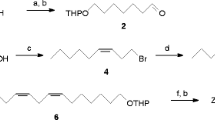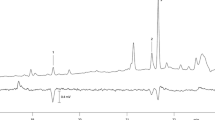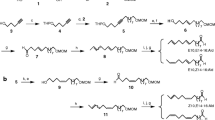Abstract
Female tip extracts of the variegated leafroller moth,Platynota flavedana (Clemens), were analyzed and found to contain a mixture of (E)-11-tetradecen-1-ol and (Z)-11-tetradecen-1-ol (9∶1), as well as a mixture of (E)-11-tetradecenyl acetate and (Z)-11-tetradecenyl acetate (2-3∶1). Small amounts of tetradecen-1-ol and tetradecyl acetate probably are also present. In the field, a mixture of the two alcohols (84∶16,E∶Z ratio) attracted significantly more male moths of this species than any other mixture tested. The data indicate that the acetates are probably not used as pheromone components.
Similar content being viewed by others
References
Baker, J.L., Hill, A.S., Cardé, R.T., Kurokawa, A., andRoelofs, W.L. 1975. Sex pheromone field trapping of the omnivorous leafroller,Platynota stultana.Environ. Entomol. 4:90–92.
Cardé, R.T., Cardé, A.M., Hill, A.S., andRoelofs, W.L. 1977. Sex attractant specificity as a reproductive isolating mechanism among the sibling speciesArchips argyrospilus andA. mortuanus and other sympatric tortricine moths (Lepidoptera: Tortricidae).J. Chem. Ecol. (3:71–84).
Chapman, P.J., andLienk, S.E. 1971.Tortricid Fauna of Apple in New York. Special Publication, N. Y. S. Agric. Expt. Sta., Geneva, New York, 82 pp.
Glass, E.H., andHervey, G.E.R. 1962. Continuous rearing of the red-banded leaf roller,Argyrotaenia velutinana.J. Econ. Entomol. 55:336–340.
Hill, A., Cardé, R., Comeau, A., Bode, W., andRoelofs, W. 1974. Sex pheromones of the tufted apple bud moth(Platynota idaeusalis).Environ. Entomol. 3:249–252.
Hill, A.S., andRoelofs, W.L. 1975. Sex pheromone components of the omnivorous leafroller moth,Platynota stultana.J. Chem. Ecol. 1:91–99.
Miller, J.R., Baker, T.C., Cardé, R.T., andRoelofs, W.L. 1976. Reinvestigation of oak leafroller sex pheromone components and the hypothesis that they vary with diet.Science 192:140–143.
Roelofs, W. 1976. The scope and limitation of the electroantennogram technique in identifying pheromone components.In N.R. McFarlane (ed.),The evaluation of biological activity. Academic Press, New York. In press.
Roelofs, W., Cardé, A., Hill, A., andCardé, R. 1976. Sex pheromone of the threelined leafroller,Pandemis limitata.Environ. Entomol. 5:649–652.
Roelofs, W., Hill, A., Cardé, R., Tette, J., Madsen, H., andVakenti, J. 1974. Sex pheromones of the fruit tree leafroller moth,Archips argyrospilus.Environ. Entomol. 3:747–751.
Roelofs, W., Hill, A., andCardé, R. 1975. Sex pheromone components of the red-banded leafroller,Argyrotaenia velutinana (Lepidoptera: Tortricidae).J. Chem. Ecol. 1:83–89
Roelofs, W., andTette, J. 1970. Sex pheromone of the oblique-banded leaf roller.Nature 226:1172.
Roelofs, W., Tette, J., Taschenberg, F., andComeau, A. 1971. Sex pheromone of the grape berry moth: Identification by classical and electroantennogram methods, and field tests.J. Insect Physiol. 17:2235–2243.
Author information
Authors and Affiliations
Additional information
Lepidoptera:Tortricidae:Tortricinae.
This research was supported in part by the Rockefeller Foundation and by NSF Grant No. GB-38020.
Rights and permissions
About this article
Cite this article
Hill, A.S., Cardé, R.T., Bode, W.M. et al. Sex pheromone components of the variegated leafroller moth,Platynota flavedana . J Chem Ecol 3, 369–376 (1977). https://doi.org/10.1007/BF00988180
Received:
Revised:
Issue Date:
DOI: https://doi.org/10.1007/BF00988180




